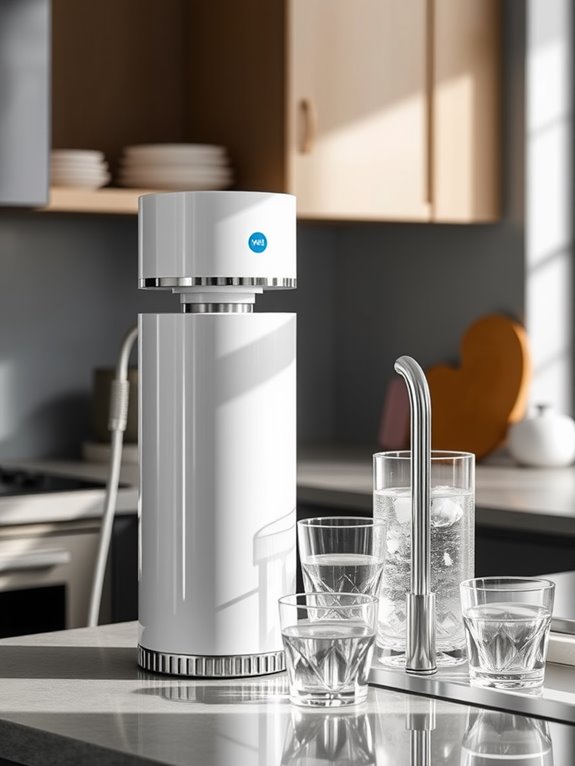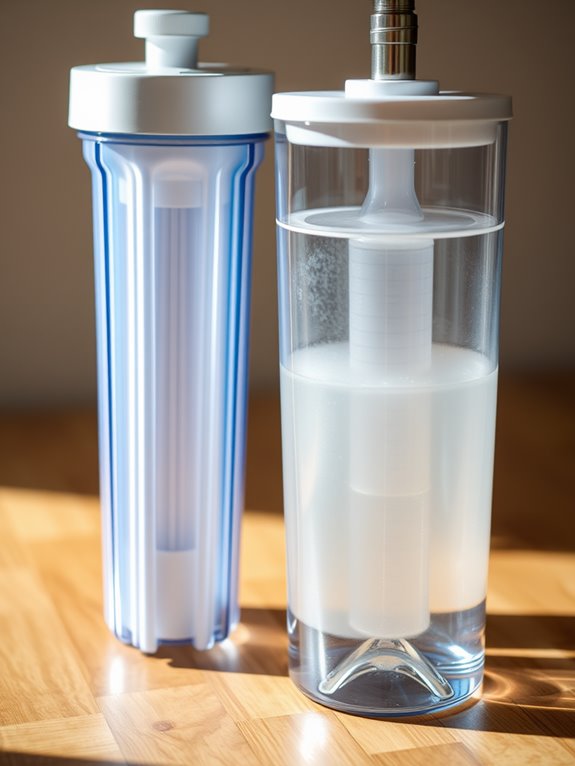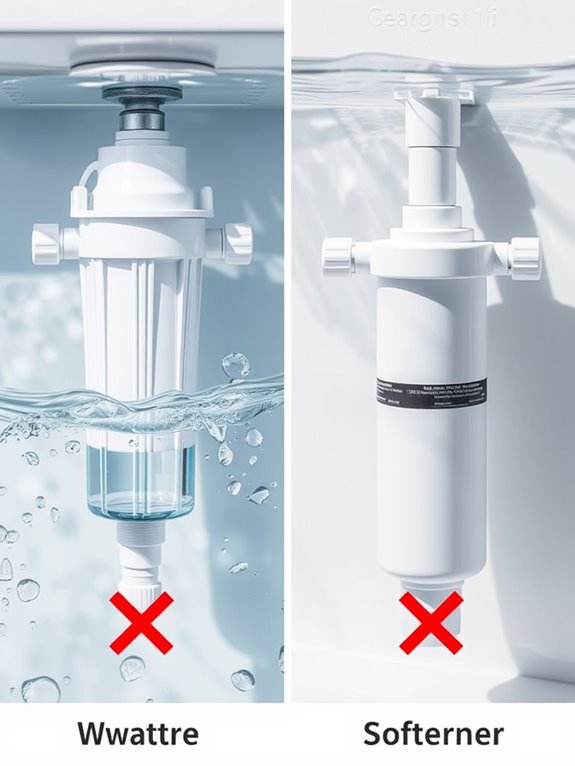You should install a water filter before your softener. Doing this guarantees that contaminants are removed first, letting the softener focus on softening hard minerals like calcium and magnesium. This setup maximizes the efficiency of both systems, protecting the softener from potential damage and enhancing overall water quality. Plus, it helps maintain your plumbing and appliances. Keep exploring to uncover more tips on optimizing your water systems for the best experience.
Understanding Water Filtration and Softening Systems

When you understand the differences between water filtration and softening systems, you can make informed choices about your home’s water quality.
Filtration systems remove contaminants like chlorine, bacteria, and sediment, improving taste and safety. On the other hand, water softeners target hard minerals like calcium and magnesium, preventing scale buildup in pipes and appliances.
Both systems serve distinct purposes, but they can work together for ideal results. Knowing what each system does helps you decide what’s best for your needs.
Assess your water source, and you’ll be better equipped to choose the right system to enhance your water quality effectively.
The Role of a Water Softener
A water softener plays an essential role in improving your home’s water quality by removing hard minerals that can cause issues like scale buildup and reduced appliance efficiency.
By exchanging calcium and magnesium ions for sodium, it softens your water, making it more suitable for daily use. You’ll notice improved lathering in soaps and detergents, leading to cleaner dishes and softer laundry.
Additionally, a water softener helps extend the lifespan of your plumbing and appliances, reducing maintenance costs.
Don’t miss out on related tips: Read this next: Are Water Filter Cartridges Recyclable? A Guide to Sustainable Choices
The Purpose of a Water Filter

A water filter serves an essential role in your home by removing contaminants that can affect your health.
It also enhances the taste and odor of your water, making it more enjoyable to drink.
Understanding its purpose helps you appreciate the importance of clean water in your daily life.
Water Contaminant Removal
Water filters play an essential role in ensuring the purity of your drinking water by effectively removing harmful contaminants. They target pollutants like chlorine, lead, bacteria, and sediment that can compromise your health.
By using a water filter, you reduce the risk of exposure to these dangerous substances, making your water safer to consume. Depending on the type of filter, you can also tackle specific issues like heavy metals or pesticides.
Incorporating a filter into your water system not only safeguards your health but also provides peace of mind, knowing that you’re drinking clean, safe water every day.
Improving Taste and Odor
While ensuring your water is free from contaminants is essential for health, improving the taste and odor of your drinking water enhances your overall experience. A water filter can effectively remove unpleasant flavors and smells, making your hydration more enjoyable. Here are some common taste and odor issues and solutions:
| Issue | Solution |
|---|---|
| Chlorine taste | Activated carbon filter |
| Metallic flavor | Reverse osmosis |
| Sulfur smell | Granular activated carbon |
Using a filter helps you sip with satisfaction, ensuring every glass of water is fresh, clean, and delightful. Don’t underestimate the power of good-tasting water!
Don’t miss out on related tips: Read this next: Is the Water Plumbed to Your Laundry Sink Potable?
Best Practices for System Setup
Setting up your water filter and softener system correctly is essential for guaranteeing ideal performance and longevity.
First, determine the order of installation: typically, the water filter should be placed before the softener. This allows the filter to remove sediments and impurities, protecting the softener from damage.
Next, make sure to follow the manufacturer’s guidelines for plumbing connections. Use high-quality fittings to prevent leaks.
Regularly check and maintain both systems to guarantee peak function.
Finally, consider testing your water before and after installation to monitor improvements in quality.
Proper setup will enhance your water experience for years to come.
There’s more to explore! Here’s another valuable read: Are Water Softener Systems Worth It? Pros, Cons, and Real-Life Reviews
Potential Issues With Incorrect Installation

Improper installation of your water filter and softener can lead to a host of problems that compromise their effectiveness.
If your water filter is placed after the softener, it mightn’t remove certain contaminants effectively, as softened water can have increased sodium levels. Conversely, if the softener is installed first, sediments and impurities can clog it, reducing its lifespan.
You may also experience issues like decreased water pressure, inefficient mineral removal, and possible damage to your appliances.
Ensuring proper placement is vital for ideal performance and to avoid costly repairs down the line. Always consult with a professional if unsure.
Here’s another post you might find useful: Best Hard Water Shower Filters: Protect Your Skin and Hair
Maintenance Tips for Both Systems
To keep your water filter and softener running smoothly, you’ll want to replace filters regularly and stick to a cleaning schedule.
This not only improves efficiency but also extends the lifespan of both systems.
Staying proactive with maintenance helps guarantee you always have clean, soft water at home.
Regular Filter Replacement
Regular filter replacement is essential for maintaining the efficiency of your water filter and softener systems. Neglecting this can lead to reduced performance and potential damage. Check your manufacturer’s guidelines for replacement intervals. Typically, you’ll want to replace filters every 6-12 months.
Here’s a quick reference table to help you:
| System | Replacement Frequency | Signs of Replacement |
|---|---|---|
| Water Filter | Every 6-12 months | Reduced water flow |
| Softener Filter | Every 2-3 years | Hardness in water |
| Pre-filter | Every 6-12 months | Discoloration or odors |
System Cleaning Schedule
While you might think that replacing filters is enough, establishing a system cleaning schedule is crucial for ideal performance of both your water filter and softener.
Aim to clean your water filter every six months, and check your softener’s resin for build-up or salt bridges quarterly.
Don’t forget to flush the softener system to prevent clogs and guarantee efficiency. Set reminders on your calendar to stay on track.
Regular maintenance not only improves water quality but also extends the lifespan of your systems.
Conclusion
When setting up your water systems, remember that about 85% of U.S. households have hard water, making a water softener essential. Placing the water filter after the softener guarantees you get clean, soft water for drinking and cooking. This setup not only improves taste but also extends the life of your plumbing. By following best practices and maintaining both systems, you’ll enjoy the benefits of pure, softened water every day. Stay informed, and your home will thrive!

I’m Allen Kim, the chief editor of plumbinginto. I am a mid level plumber and assign to an local firm over 4 years of experience. During the working period, most of my experience is related to the house plumbing. I learned about the thing, when working with most experienced people in this sector, one must be as good as the inspector or better with knowledge of the project as well as the practical aspects of plumbing industry.